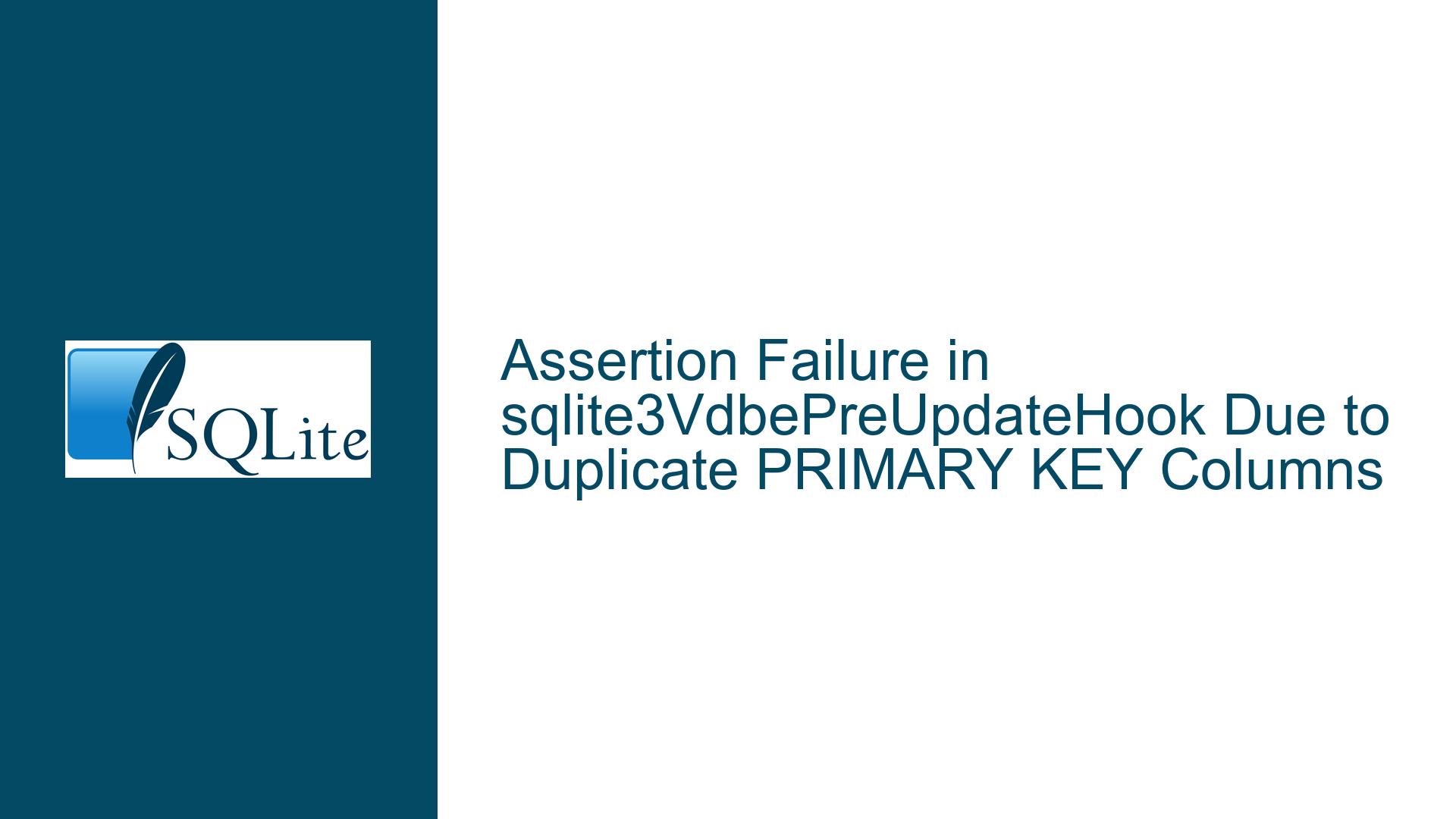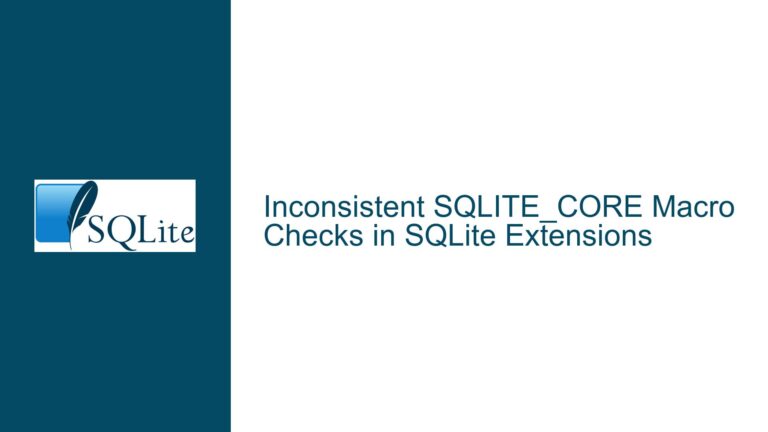Assertion Failure in sqlite3VdbePreUpdateHook Due to Duplicate PRIMARY KEY Columns
Understanding the Assertion Failure in sqlite3VdbePreUpdateHook
The core issue revolves around an assertion failure in the sqlite3VdbePreUpdateHook function, which is triggered during the execution of a specific SQLite query sequence. The failure occurs when attempting to create and populate a table with a PRIMARY KEY constraint that includes duplicate column definitions. Specifically, the table v0 is defined with a PRIMARY KEY that includes the same column c0 twice, once without a collation and once with the NOCASE collation. This design choice, while syntactically valid, leads to an internal inconsistency in SQLite’s handling of the PRIMARY KEY constraint during the pre-update hook execution.
The assertion failure message indicates a mismatch between the number of fields in the cursor (pCsr->nField) and the expected number of real columns (nRealCol). The assertion expects these values to match unless the operation is a SQLITE_DELETE and a specific condition involving the register index (iReg) is met. However, in this case, the assertion fails because the cursor’s field count does not align with the expected column count, suggesting an underlying issue with how SQLite processes the PRIMARY KEY definition.
This issue is particularly interesting because it highlights a subtle edge case in SQLite’s handling of PRIMARY KEY constraints, especially when collations are involved. The presence of duplicate column names in the PRIMARY KEY definition, combined with the WITHOUT ROWID table option, exacerbates the problem, leading to the assertion failure. This scenario underscores the importance of understanding how SQLite internally manages table schemas and constraints, particularly in edge cases that may not be immediately obvious.
Exploring the Root Causes of the Assertion Failure
The assertion failure in sqlite3VdbePreUpdateHook can be attributed to several interrelated factors, each contributing to the mismatch between the cursor’s field count and the expected column count. The primary cause lies in the table definition itself, specifically the PRIMARY KEY constraint that includes the same column c0 twice, once with a NOCASE collation. This duplication creates an ambiguity in how SQLite processes the PRIMARY KEY constraint, leading to inconsistencies in the internal data structures used during query execution.
When SQLite processes a PRIMARY KEY constraint, it creates an internal index to enforce the constraint. In the case of the v0 table, the PRIMARY KEY constraint includes the same column c0 twice, which is unusual but not explicitly prohibited by SQLite’s syntax rules. However, this duplication causes SQLite to generate an index with two entries for the same column, leading to confusion in the cursor’s field count. The NOCASE collation further complicates matters by introducing additional logic for case-insensitive comparisons, which may not be fully accounted for in the pre-update hook logic.
Another contributing factor is the use of the WITHOUT ROWID table option. This option changes the way SQLite stores and retrieves data, eliminating the implicit rowid column and relying solely on the PRIMARY KEY for row identification. In this case, the WITHOUT ROWID option forces SQLite to use the PRIMARY KEY as the sole means of identifying rows, which exacerbates the issues caused by the duplicate column definition. The combination of these factors leads to the assertion failure in sqlite3VdbePreUpdateHook, as the cursor’s field count no longer aligns with the expected column count.
The compilation flags used during the build process may also play a role in exposing this issue. The flags -DSQLITE_DEBUG, -DSQLITE_ENABLE_TREETRACE, and -DSQLITE_ENABLE_WHERETRACE enable additional debugging and tracing features, which can help identify the root cause of the assertion failure. However, these flags also increase the complexity of the SQLite binary, potentially introducing additional edge cases that may not be present in a standard build. The -DSQLITE_ENABLE_CURSOR_HINTS flag, in particular, may influence how SQLite handles cursors during query execution, further complicating the issue.
Resolving the Assertion Failure: Steps, Solutions, and Fixes
To resolve the assertion failure in sqlite3VdbePreUpdateHook, several steps can be taken, ranging from modifying the table definition to applying patches or workarounds. The first and most straightforward solution is to avoid defining a PRIMARY KEY constraint with duplicate columns, as this is the root cause of the issue. Instead, the table definition should be revised to include only unique columns in the PRIMARY KEY constraint. For example, the v0 table could be redefined as follows:
CREATE TABLE v0 (c0, c1, PRIMARY KEY(c0, c1 COLLATE NOCASE)) WITHOUT ROWID;
This revised definition eliminates the duplicate column in the PRIMARY KEY constraint, ensuring that the cursor’s field count aligns with the expected column count. By introducing a second column c1, the PRIMARY KEY constraint becomes unambiguous, and the assertion failure should no longer occur.
If modifying the table definition is not feasible, another approach is to apply the patch referenced in the discussion. The patch, identified by the commit hash 53a61f7423a7f057, addresses a similar issue and may resolve the assertion failure in this case. To apply the patch, follow these steps:
- Clone the SQLite source code repository from the official website.
- Check out the commit corresponding to the patch using the command
git checkout 53a61f7423a7f057. - Rebuild SQLite using the same compilation flags as before.
Applying the patch may resolve the assertion failure by modifying the internal logic of sqlite3VdbePreUpdateHook to handle the duplicate column definition more gracefully. However, this approach should be used with caution, as it involves modifying the SQLite source code and may introduce other issues.
In cases where neither modifying the table definition nor applying the patch is feasible, a workaround can be implemented by avoiding the use of the WITHOUT ROWID table option. While this option provides performance benefits in certain scenarios, it also introduces additional complexity in how SQLite handles PRIMARY KEY constraints. By removing the WITHOUT ROWID option, the table definition becomes simpler, and the assertion failure may be avoided. For example:
CREATE TABLE v0 (c0, PRIMARY KEY(c0, c0 COLLATE NOCASE));
This revised definition retains the duplicate column in the PRIMARY KEY constraint but eliminates the WITHOUT ROWID option, potentially resolving the assertion failure. However, this approach may not be suitable for all use cases, as it changes the underlying storage mechanism of the table.
Finally, if none of the above solutions are viable, it may be necessary to disable the assertion in the SQLite source code. This approach should be used as a last resort, as it involves modifying the SQLite source code and may mask underlying issues. To disable the assertion, locate the line in sqlite3.c where the assertion is defined (line 88091 in this case) and comment it out. Rebuild SQLite using the same compilation flags as before, and the assertion failure should no longer occur. However, this approach is not recommended, as it may lead to undefined behavior in other parts of the SQLite codebase.
In conclusion, the assertion failure in sqlite3VdbePreUpdateHook can be resolved by modifying the table definition, applying a patch, avoiding the WITHOUT ROWID option, or disabling the assertion. Each approach has its own trade-offs, and the best solution depends on the specific requirements of the use case. By understanding the root causes of the issue and carefully considering the available options, it is possible to resolve the assertion failure and ensure the smooth operation of SQLite.






